Lightweight Scheme for Secure Signaling and Data Exchanges in Intelligent Precision Agriculture
Abstract
1. Introduction
- We timestamp all the exchanged messages and validate them at the receiver end so as to thwart any packet replays.
- Frequently refreshed random numbers are incorporated in intermediary parameters to prevent against forgery and spoofing attacks.
- Elaborate formal security substantiation is executed to demonstrate the security verifiability of the negotiated session keys.
- Extensive semantic security analyses are executed, with results showing the resilience of our protocol against myriad precision agriculture threats.
- We carry out comparative performance evaluations to demonstrate the efficiency of our scheme. Specifically, this protocol is shown to consume the lowest energy and computation overheads at relatively low communication costs.
1.1. Motivation
1.2. Research Goals
1.3. Threat Model
2. Related Works
3. The Proposed Scheme
3.1. Registration
| Algorithm 1: Sensor node and user registration |
| Begin ** Sensor registration **
End |
3.1.1. Sensor Registration
3.1.2. User Registration
3.2. Login and Authentication
| Algorithm 2: Login and authentication |
Begin
|
3.3. Parameter Update Phase
4. Security Analysis
4.1. Formal Security Evaluation
4.2. Informal Security Analysis
5. Comparative Performance Evaluations
5.1. Computation Overheads
5.2. Communication Overheads
5.3. Energy Consumption
5.4. Supported Functionalities
6. Conclusions
Author Contributions
Funding
Data Availability Statement
Conflicts of Interest
References
- Torky, M.; Hassanein, A.E. Integrating Blockchain and the Internet of Things in Precision Agriculture: Analysis, Opportunities, and Challenges. Comput. Electron. Agric. 2020, 178, 105476. [Google Scholar] [CrossRef]
- Fathy, C.; Ali, H.M. A Secure IoT-Based Irrigation System for Precision Agriculture Using the Expeditious Cipher. Sensors 2023, 23, 2091. [Google Scholar] [CrossRef]
- Vangala, A.; Das, A.K.; Mitra, A.; Das, S.K.; Park, Y. Blockchain-Enabled Authenticated Key Agreement Scheme for Mobile Vehicles-Assisted Precision Agricultural IoT Networks. IEEE Trans. Inf. Forensics Secur. 2023, 18, 904–919. [Google Scholar] [CrossRef]
- Munaganuri, R.K.; Rao, Y.N. PAMICRM: Improving Precision Agriculture through Multimodal Image Analysis for Crop Water Requirement Estimation Using Multidomain Remote Sensing Data Samples. IEEE Access 2024, 12, 52815–52836. [Google Scholar] [CrossRef]
- Lanucara, S.; Praticò, S.; Pioggia, G.; Di Fazio, S.; Modica, G. Web-Based Spatial Decision Support System for Precision Agriculture: A Tool for Delineating Dynamic Management Unit Zones (MUZs). Smart Agric. Technol. 2024, 8, 100444. [Google Scholar] [CrossRef]
- Rangwani, D.; Sadhukhan, D.; Ray, S.; Khan, M.K.; Dasgupta, M. An Improved Privacy Preserving Remote User Authentication Scheme for Agricultural Wireless Sensor Network. Trans. Emerg. Telecommun. Technol. 2021, 32, e4218. [Google Scholar] [CrossRef]
- Abduljabbar, Z.A.; Nyangaresi, V.O.; Jasim, H.M.; Ma, J.; Hussain, M.A.; Hussien, Z.A.; Aldarwish, A.J.Y. Elliptic Curve Cryptography-Based Scheme for Secure Signaling and Data Exchanges in Precision Agriculture. Sustainability 2023, 15, 10264. [Google Scholar] [CrossRef]
- Raj, M.; Harshini; Gupta, S.; Atiquzzaman, M.; Rawlley, O.; Goel, L. Leveraging Precision Agriculture Techniques Using UAVs and Emerging Disruptive Technologies. Energy Nexus 2024, 14, 100300. [Google Scholar] [CrossRef]
- Sonavane, S.M.; Prashantha, G.R.; Nikam, P.D.; Mayuri, A.V.R.; Chauhan, J.; Sountharrajan, S.; Bavirisetti, D.P. Optimizing QoS and Security in Agriculture IoT Deployments: A Bioinspired Q-Learning Model with Customized Shards. Heliyon 2024, 10, e24224. [Google Scholar] [CrossRef] [PubMed]
- You, M.; Kim, Y.; Kim, J.; Seo, M.; Son, S.; Shin, S.; Lee, S. FuzzDocs: An Automated Security Evaluation Framework for IoT. IEEE Access 2022, 10, 102406–102420. [Google Scholar] [CrossRef]
- Bouzidi, M.; Gupta, N.; Cheikh, F.A.; Shalaginov, A.; Derawi, M. A Novel Architectural Framework on IoT Ecosystem, Security Aspects and Mechanisms: A Comprehensive Survey. IEEE Access 2022, 10, 101362–101384. [Google Scholar] [CrossRef]
- Luo, F.; Huang, R.; Xie, Y. Hybrid Blockchain-Based Many-to-Many Cross-Domain Authentication Scheme for Smart Agriculture IoT Networks. J. King Saud Univ.-Comput. Inf. Sci. 2024, 36, 101946. [Google Scholar] [CrossRef]
- Mutlaq, K.A.-A.; Nyangaresi, V.O.; Omar, M.A.; Abduljabbar, Z.A.; Abduljaleel, I.Q.; Ma, J.; Al Sibahee, M.A. Low Complexity Smart Grid Security Protocol Based on Elliptic Curve Cryptography, Biometrics and Hamming Distance. PLoS ONE 2024, 19, e0296781. [Google Scholar] [CrossRef] [PubMed]
- Huang, H.; Zhou, S.; Lin, J.; Zhang, K.; Guo, S. Bridge the Trustworthiness Gap amongst Multiple Domains: A Practical Blockchain-Based Approach. In Proceedings of the ICC 2020—2020 IEEE International Conference on Communications (ICC), Dublin, Ireland, 7–11 June 2020. [Google Scholar]
- Wu, H.-T.; Tsai, C.-W. An Intelligent Agriculture Network Security System Based on Private Blockchains. J. Commun. Netw. 2019, 21, 503–508. [Google Scholar] [CrossRef]
- Vangala, A.; Sutrala, A.K.; Das, A.K.; Jo, M. Smart Contract-Based Blockchain-Envisioned Authentication Scheme for Smart Farming. IEEE Internet Things J. 2021, 8, 10792–10806. [Google Scholar] [CrossRef]
- Wang, L.; Xu, L.; Zheng, Z.; Liu, S.; Li, X.; Cao, L.; Li, J.; Sun, C. Smart Contract-Based Agricultural Food Supply Chain Traceability. IEEE Access 2021, 9, 9296–9307. [Google Scholar] [CrossRef]
- Bera, B.; Vangala, A.; Das, A.K.; Lorenz, P.; Khan, M.K. Private Blockchain-Envisioned Drones-Assisted Authenti-Cation Scheme in IoT-Enabled Agricultural Environment. Comput. Stand. Interfaces 2022, 80, 103567. [Google Scholar] [CrossRef]
- Xue, L.; Huang, H.; Xiao, F.; Wang, W. A Cross-Domain Authentication Scheme Based on Cooperative Blockchains Functioning with Revocation for Medical Consortiums. IEEE Trans. Netw. Serv. Manag. 2022, 19, 2409–2420. [Google Scholar] [CrossRef]
- Shen, M.; Liu, H.; Zhu, L.; Xu, K.; Yu, H.; Du, X.; Guizani, M. Blockchain-Assisted Secure Device Authentication for Cross-Domain Industrial IoT. IEEE J. Sel. Areas Commun. 2020, 38, 942–954. [Google Scholar] [CrossRef]
- Yang, Y.; Wei, L.; Wu, J.; Long, C.; Li, B. A Blockchain-Based Multidomain Authentication Scheme for Conditional Privacy Preserving in Vehicular Ad-Hoc Network. IEEE Internet Things J. 2022, 9, 8078–8090. [Google Scholar] [CrossRef]
- Bagga, P.; Sutrala, A.K.; Das, A.K.; Vijayakumar, P. Blockchain-Based Batch Authentication Protocol for Internet of Vehicles. J. Syst. Arch. 2021, 113, 101877. [Google Scholar] [CrossRef]
- Nyangaresi, V.O.; Jasim, H.M.; Mutlaq, K.A.A.; Abduljabbar, Z.A.; Ma, J.; Abduljaleel, I.Q.; Honi, D.G. A Symmetric Key and Elliptic Curve Cryptography-Based Protocol for Message Encryption in Unmanned Aerial Vehicles. Electronics 2023, 12, 3688. [Google Scholar] [CrossRef]
- Ali, R.; Pal, A.K.; Kumari, S.; Karuppiah, M.; Conti, M. A Secure User Authentication and Key-Agreement Scheme Using Wireless Sensor Networks for Agriculture Monitoring. Future Gener. Comput. Syst. 2018, 84, 200–215. [Google Scholar] [CrossRef]
- Chen, M.; Lee, T.-F.; Pan, J.-I. An Enhanced Lightweight Dynamic PseudonymIdentity Based Authentication and Key AgreementScheme Using Wireless Sensor Networks for Agriculture Monitoring. Sensors 2019, 19, 1146. [Google Scholar] [CrossRef] [PubMed]
- Alyahya, S.; Khan, W.U.; Ahmed, S.; Marwat, S.N.K.; Habib, S. Cyber Secure Framework for Smart Agriculture: Robust and Tamper-Resistant Authentication Scheme for IoT Devices. Electronics 2022, 11, 963. [Google Scholar] [CrossRef]
- Bothe, A.; Bauer, J.; Aschenbruck, N. RFID-Assisted Continuous User Authentication for IoT-Based Smart Farming. In Proceedings of the 2019 IEEE International Conference on RFID Technology and Applications (RFID-TA), Pisa, Italy, 25–27 September 2019. [Google Scholar]
- Hussien, Z.A.; Abdulmalik, H.A.; Hussain, M.A.; Nyangaresi, V.O.; Ma, J.; Abduljabbar, Z.A.; Abduljaleel, I.Q. Lightweight Integrity Preserving Scheme for Secure Data Exchange in Cloud-Based IoT Systems. Appl. Sci. 2023, 13, 691. [Google Scholar] [CrossRef]
- Panda, S.S.; Jena, D.; Mohanta, B.K.; Ramasubbareddy, S.; Daneshmand, M.; Gandomi, A.H. Authentication and Key Management in Distributed IoT Using Blockchain Technology. IEEE Internet Things J. 2021, 8, 12947–12954. [Google Scholar] [CrossRef]
- Vangala, A.; Das, A.K.; Lee, J.-H. Provably Secure Signature-based Anonymous User Authentication Protocol in an Internet of Things-enabled Intelligent Precision Agricultural Environment. Concurr. Comput. 2021, 35, e6187. [Google Scholar] [CrossRef]
- Hassan, B.; Alsanad, A.A.; Ullah, I.; Amin, N.U.; Khan, M.A.; Uddin, M.I.; Wu, J.M.T. A Cost Effective Identi-Ty-Based Authentication Scheme for Internet of Things-Enabled Agriculture. Wirel. Commun. Mob. Comput. 2022, 2022, 4275243. [Google Scholar] [CrossRef]
- Harbi, Y.; Aliouat, Z.; Refoufi, A.; Harous, S.; Bentaleb, A. Enhanced Authentication and Key Management Scheme for Securing Data Transmission in the Internet of Things. Ad Hoc Netw. 2019, 94, 101948. [Google Scholar] [CrossRef]
- Yuan, E.; Wang, L.; Cheng, S.; Ao, N.; Guo, Q. A Key Management Scheme Based on Pairing-Free Identity Based Digital Signature Algorithm for Heterogeneous Wireless Sensor Networks. Sensors 2020, 20, 1543. [Google Scholar] [CrossRef]
- Mishra, D.; Dharminder, D.; Yadav, P.; Sreenivasa Rao, Y.; Vijayakumar, P.; Kumar, N. A Provably Secure Dynamic ID-Based Authenticated Key Agreement Framework for Mobile Edge Computing without a Trusted Party. J. Inf. Secur. Appl. 2020, 55, 102648. [Google Scholar] [CrossRef]
- Andola, N.; Prakash, S.; Gahlot, R.; Venkatesan, S.; Verma, S. An Enhanced Smart Card and Dynamic ID Based Remote Multi-Server User Authentication Scheme. Cluster Comput. 2022, 25, 3699–3717. [Google Scholar] [CrossRef]
- Gupta, D.S.; Islam, S.K.H.; Obaidat, M.S.; Vijayakumar, P.; Kumar, N.; Park, Y. A Provably Secure and Lightweight Identity-Based Two-Party Authenticated Key Agreement Protocol for IIoT Environments. IEEE Syst. J. 2021, 15, 1732–1741. [Google Scholar] [CrossRef]
- Liu, J.; Liu, R.; Lai, Y. Risk-Based Dynamic Identity Authentication Method Based on the UCON Model. Secur. Commun. Netw. 2022, 2022, 1–13. [Google Scholar] [CrossRef]
- Sibahee, A.; Nyangaresi, M.A.; Abduljabbar, V.O.; Luo, Z.A.; Zhang, C.; Ma, J. Two-Factor Privacy Preserving Protocol for Efficient Authentication in Internet of Vehicles Networks. IEEE Internet Things J. 2023, 11, 14253–14266. [Google Scholar] [CrossRef]
- Li, Y.; Cheng, Q.; Shi, W. Security Analysis of a Lightweight Identity-Based Two-Party Authenticated Key Agreement Protocol for IIoT Environments. Secur. Commun. Netw. 2021, 2021, 1–6. [Google Scholar] [CrossRef]
- Li, X.; Niu, J.; Bhuiyan, M.Z.A.; Wu, F.; Karuppiah, M.; Kumari, S. A Robust ECC-Based Provable Secure Authen-Tication Protocol with Privacy Preserving for Industrial Internet of Things. IEEE Trans. Ind. Inform. 2017, 14, 3599–3609. [Google Scholar] [CrossRef]
- Eddine, M.S.; Ferrag, M.A.; Friha, O.; Maglaras, L. EASBF: An Efficient Authentication Scheme over Blockchain for Fog Computing-Enabled Internet of Vehicles. J. Inf. Secur. Appl. 2021, 59, 102802. [Google Scholar] [CrossRef]
- Tomar, A.; Tripathi, S. Blockchain-Assisted Authentication and Key Agreement Scheme for Fog-Based Smart Grid. Clust. Comput. 2022, 25, 451–468. [Google Scholar] [CrossRef]
- Itoo, S.; Khan, A.A.; Kumar, V.; Alkhayyat, A.; Ahmad, M.; Srinivas, J. CKMIB: Construction of Key Agreement Protocol for Cloud Medical Infrastructure Using Blockchain. IEEE Access 2022, 10, 67787–67801. [Google Scholar] [CrossRef]
- Jia, X.; Luo, M.; Wang, H.; Shen, J.; He, D. A Blockchain-Assisted Privacy-Aware Authentication Scheme for Internet of Medical Things. IEEE Internet Things J. 2022, 9, 21838–21850. [Google Scholar] [CrossRef]
- Shuai, M.; Xiong, L.; Wang, C.; Yu, N. A Secure Authentication Scheme with Forward Secrecy for Industrial Internet of Things Using Rabin Cryptosystem. Comput. Commun. 2020, 160, 215–227. [Google Scholar] [CrossRef]
- Fan, Q.; Chen, J.; Deborah, L.J.; Luo, M. A Secure and Efficient Authentication and Data Sharing Scheme for Internet of Things Based on Blockchain. J. Syst. Arch. 2021, 117, 102112. [Google Scholar] [CrossRef]
- Mutlaq, K.A.A.; Nyangaresi, V.O.; Omar, M.A.; Abduljabbar, Z.A. Symmetric Key Based Scheme for Veri-Fication Token Generation in Internet of Things Communication Environment. In EAI International Conference on Applied Cryptography in Computer and Communications; Springer Nature: Cham, Switzerland, 2022; pp. 46–64. [Google Scholar]
- Khalid, H.; Hashim, S.J.; Ahmad, S.M.S.; Hashim, F.; Chaudhary, M.A. Robust Multi-Gateway Authentication Scheme for Agriculture Wireless Sensor Network in Society 5.0 Smart Communities. Agriculture 2021, 11, 1020. [Google Scholar] [CrossRef]
- Kumar, R.; Singh, S.; Singh, D.; Kumar, M.; Gill, S.S. A Robust and Secure User Authentication Scheme Based on Multifactor and Multi-gateway in IoT Enabled Sensor Networks. Secur. Priv. 2024, 7, e335. [Google Scholar] [CrossRef]
- Irshad, A.; Alreshoodi, M. SEMS-5G: A Secure and Efficient Multi-Server Authentication Scheme for 5G Networks. IEEE Access 2024, 12, 49062–49077. [Google Scholar] [CrossRef]
- Taji, K.; Ghanimi, F. Enhancing Security and Privacy in Smart Agriculture: A Novel Homomorphic Signcryption System. Results Eng. 2024, 22, 102310. [Google Scholar] [CrossRef]
- Itoo, S.; Khan, A.A.; Ahmad, M.; Idrisi, M.J. A Secure and Privacy-Preserving Lightweight Authentication and Key Exchange Algorithm for Smart Agriculture Monitoring System. IEEE Access 2023, 11, 56875–56890. [Google Scholar] [CrossRef]
- Nyangaresi, V.O. Provably Secure Authentication Protocol for Traffic Exchanges in Unmanned Aerial Vehicles. High-Confid. Comput. 2023, 3, 100154. [Google Scholar] [CrossRef]
- Bahache, A.N.; Chikouche, N.; Mezrag, F. Authentication Schemes for Healthcare Applications Using Wireless Medical Sensor Networks: A Survey. SN Comput. Sci. 2022, 3, 382. [Google Scholar] [CrossRef]

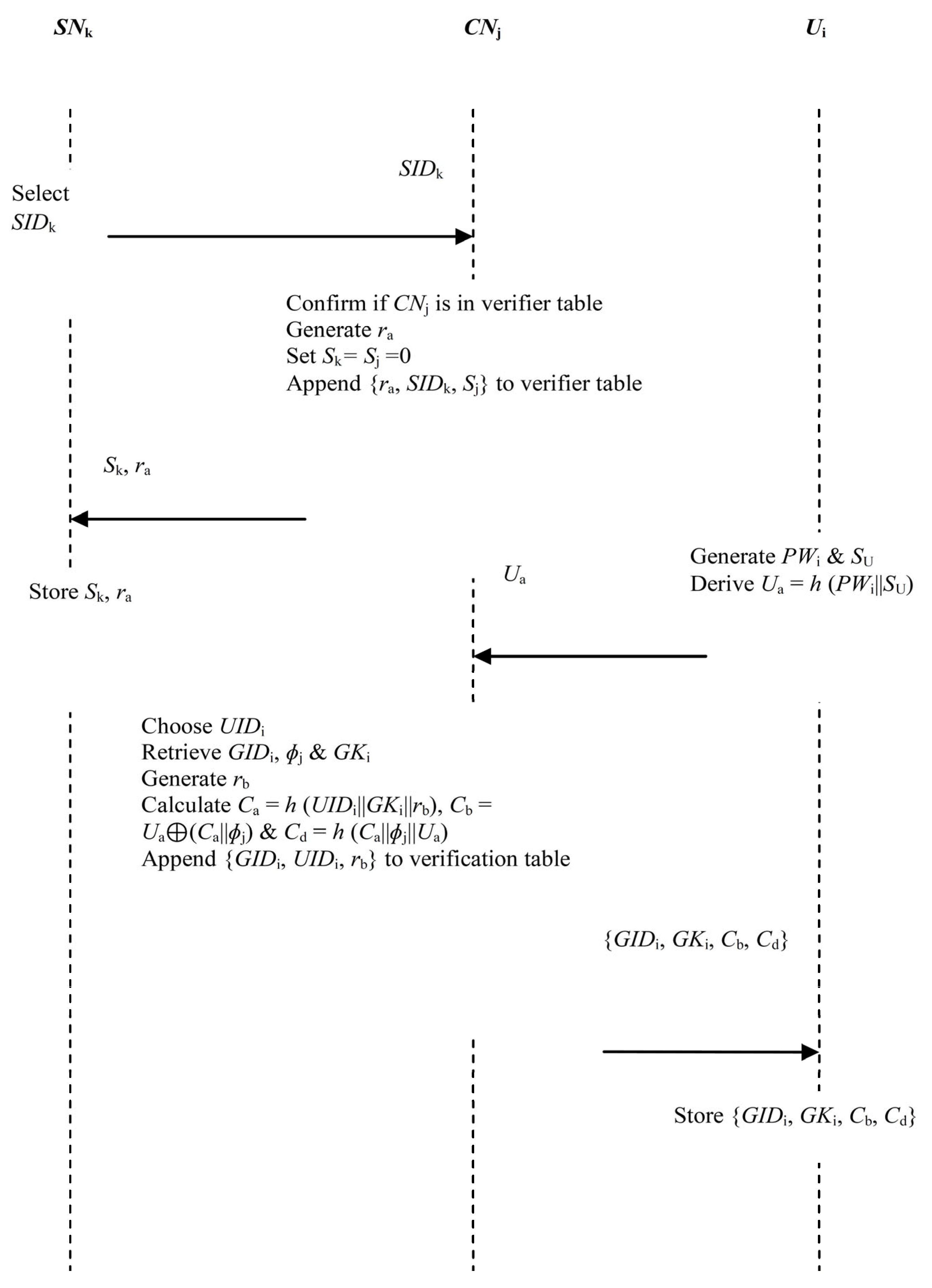
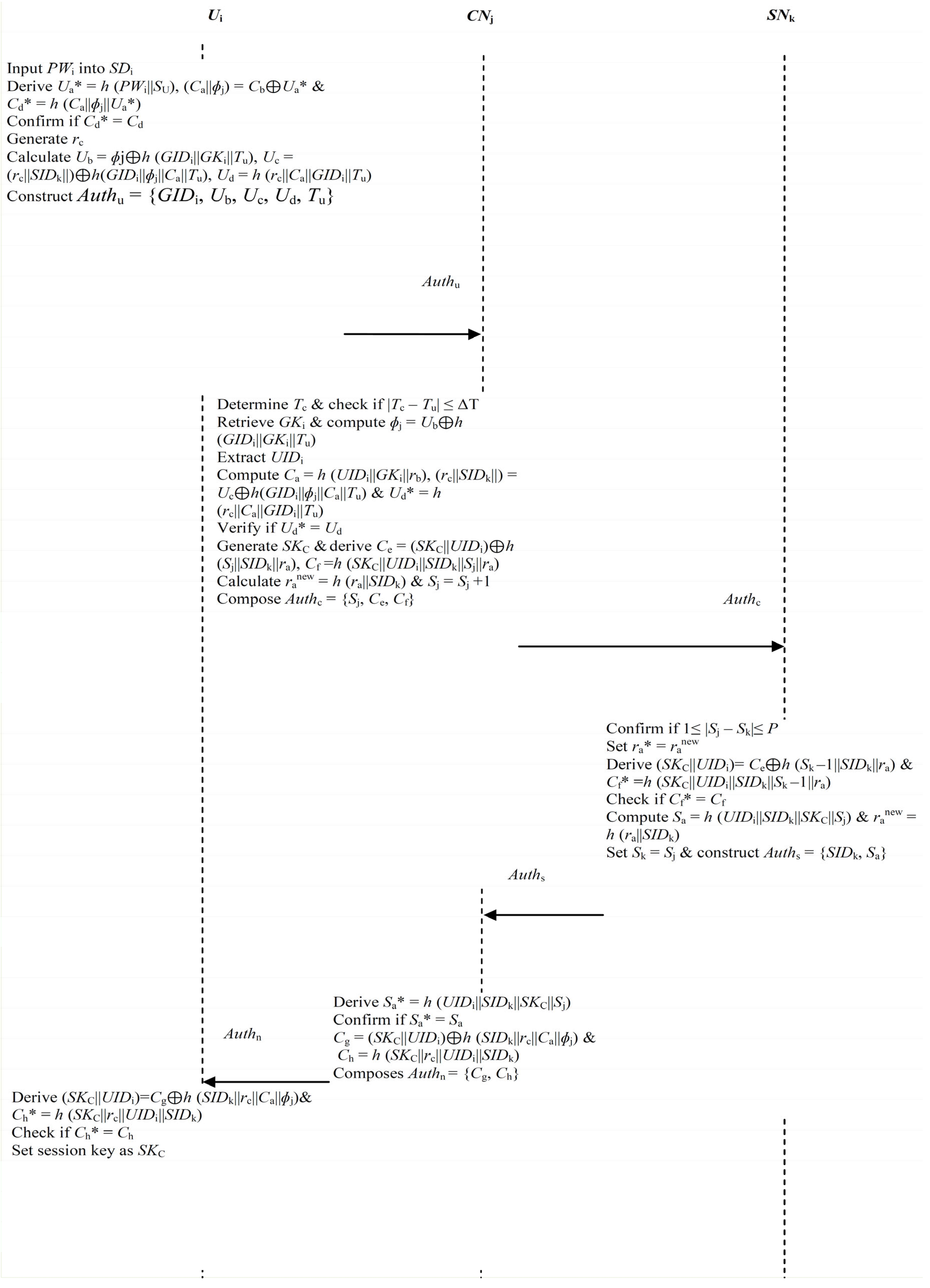
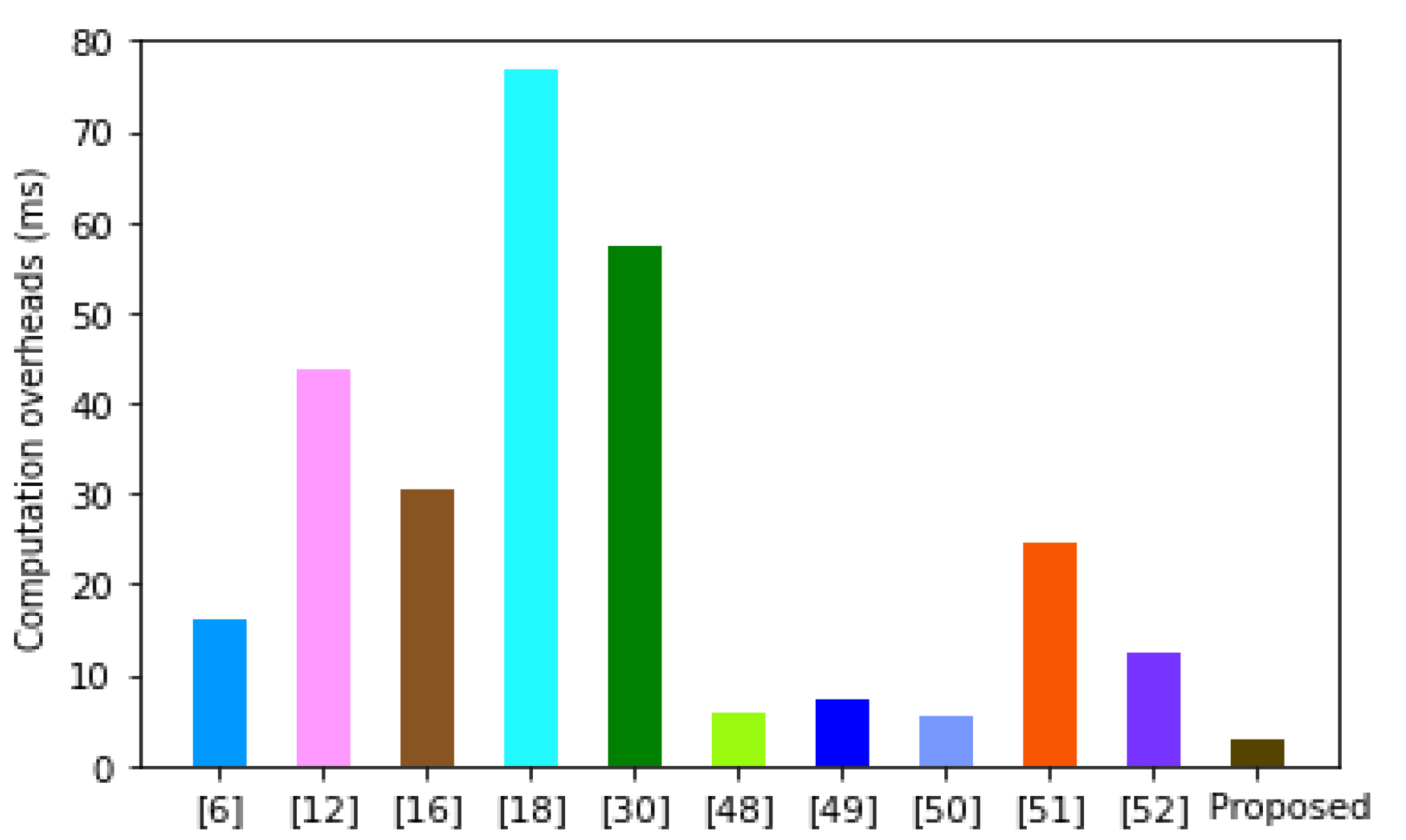
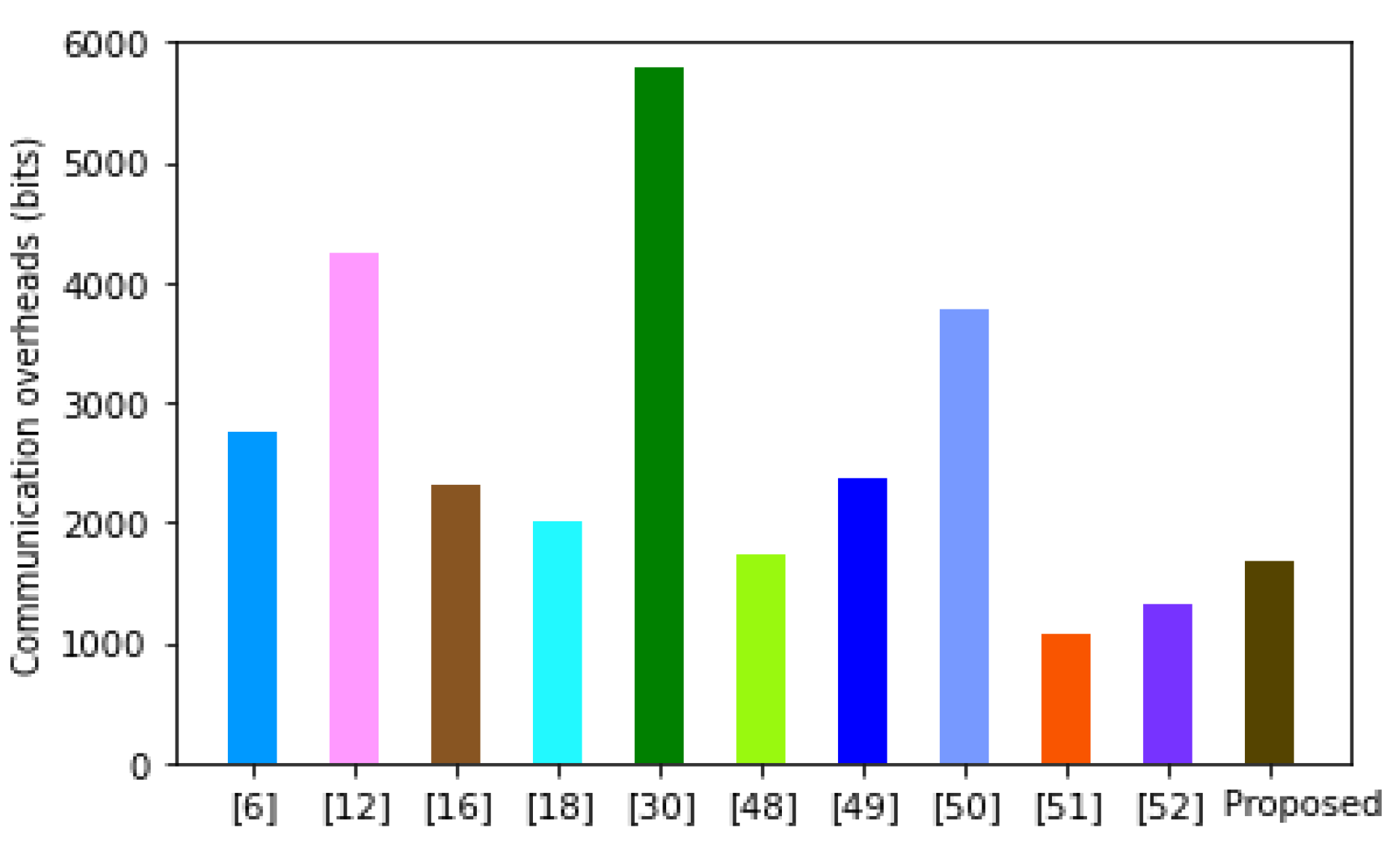
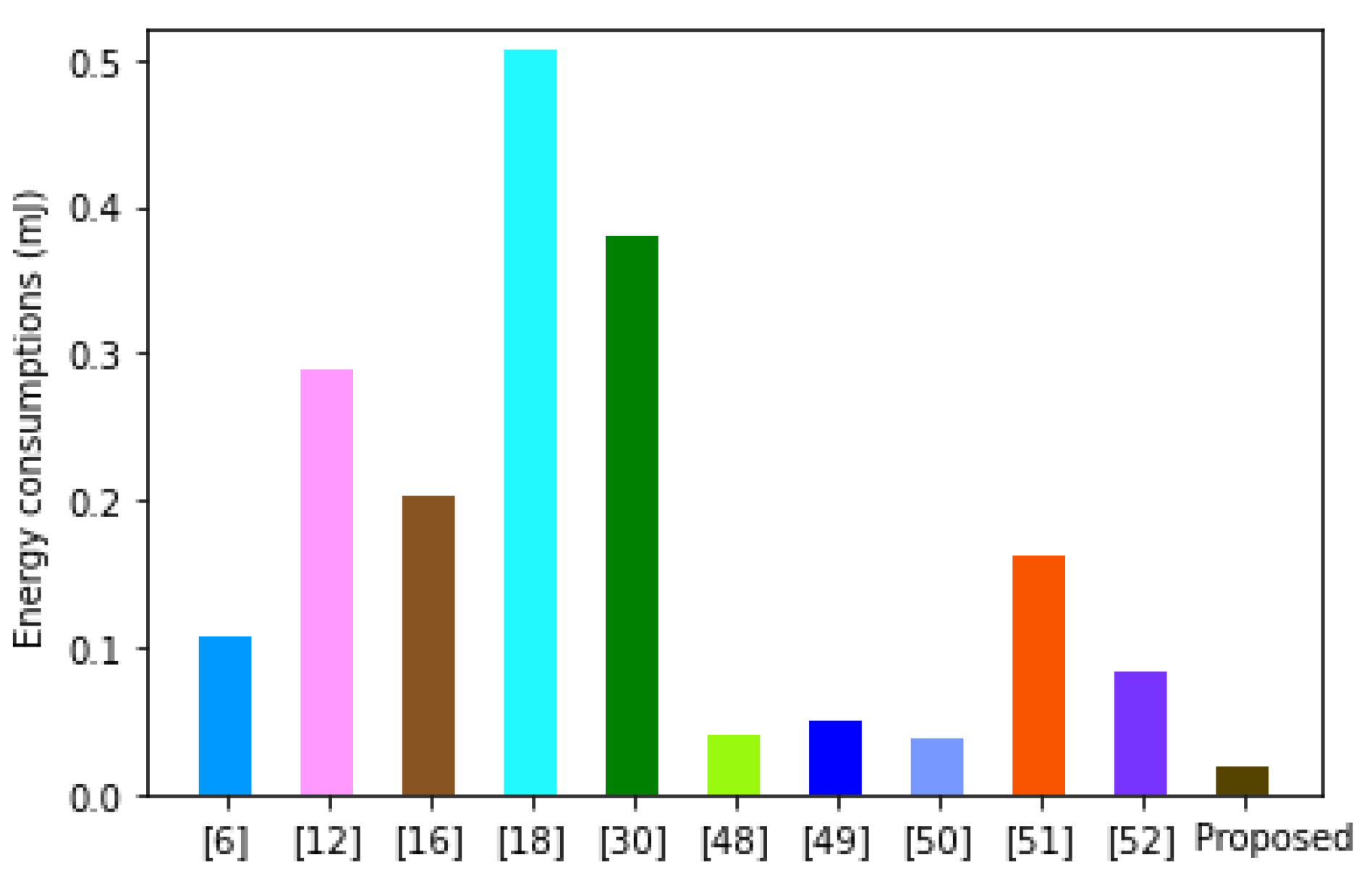
| Symbol | Description |
|---|---|
| Ui | ith smart farm user |
| SNk | Smart farm node k |
| CNj | Controller node j |
| ɸj | Secret key for CNj |
| SIDk | Unique identity belonging to SNk |
| Sk, Sj | Sequence numbers at the SNk and CNj, respectively |
| PWi, SU | User password and secret key, respectively |
| UIDi | Ui’s unique identity |
| GIDi | Pseudonym shared among users of the group |
| GKi | Group key corresponding with GIDi |
| rc, ra | Random numbers |
| Tu, Tc | Timestamps |
| VT | Verification table |
| ΔT | Maximum transmission latency |
| SKC | Session key |
| P | A pool of generated identities |
| || | Concatenation operation |
| ⊕ | XOR operation |
| Scheme | Computations | Total (ms) | ||
|---|---|---|---|---|
| User/Smart Device | Sensor | Controller/Gateway | ||
| [6] | 4Th + 2Tpm | 4Th + Tpm | 7Th + Tpm | 16.04 |
| [12] | 4Th + 5Tpm + Tpa | 3Th + 4Tpm + 2Tpa | 2Th + 3Tpm + Tpa | 43.62 |
| [16] | - | 9Th + 4Tpm | 9Th + 4Tpm | 30.54 |
| [18] | - | 7Th + 6Tpm + 2TPA + Tpe | 7Th + 6Tpm + 2TPA + Tpe | 76.82 |
| [30] | 13Th + 4Tpm + Tpa + Tfe | 9TH + 4Tpm + Tpa | 12Th + 6Tpm + 2Tpa | 57.41 |
| [48] | 9Th + Tfe + Ten | 3Th + Ten | 5Th + 5Ten | 5.91 |
| [49] | 11Th + Tfe | 6Th | 13Th | 7.37 |
| [50] | 14Th | 9Th + Ten | 20Th + Ten | 5.56 |
| [51] | 3Tpm | 4Tpm | - | 24.71 |
| [52] | 7Th + Tpm + Ten+ Tfe | 6Th + Tpm + Ten | 2Th | 12.54 |
| Proposed | 8Th | 5Th | 10Th | 2.94 |
| Scheme | Message Exchange Details | Size (Bits) |
|---|---|---|
| [6] | UGWN SN | 2752 |
| [12] | SN SM CBC SM DSP SN | 4256 |
| [16] | SN GWN SN GWN | 2304 |
| [18] | GSS DR GSS | 2016 |
| [30] | U CN SN CN U | 5792 |
| [48] | U HGWN SN U | 1728 |
| [49] | U GWN SN GWN U | 2368 |
| [50] | U SN CA SN U | 3776 |
| [51] | U AG SN AG U | 1060 |
| [52] | U GWN SN GWN U | 1312 |
| Proposed | U CN SN CN U | 1664 |
| Scheme | Energy (mJ) |
|---|---|
| [6] | 0.106 |
| [12] | 0.288 |
| [16] | 0.202 |
| [18] | 0.507 |
| [30] | 0.379 |
| [48] | 0.039 |
| [49] | 0.049 |
| [50] | 0.037 |
| [51] | 0.163 |
| [52] | 0.083 |
| Proposed | 0.019 |
| [12] | [49] | [50] | [51] | [52] | [30] | [6] | [18] | [16] | [48] | Proposed | |
|---|---|---|---|---|---|---|---|---|---|---|---|
| Security features: | |||||||||||
| F1 | √ | √ | √ | √ | √ | √ | √ | × | √ | √ | √ |
| F2 | × | √ | √ | × | √ | √ | √ | × | √ | √ | √ |
| F3 | √ | √ | √ | √ | √ | √ | √ | √ | √ | √ | √ |
| F4 | √ | √ | √ | √ | √ | √ | √ | √ | × | √ | √ |
| Robust against the following: | |||||||||||
| F5 | × | × | × | × | × | √ | √ | √ | √ | × | √ |
| F6 | × | √ | × | √ | × | √ | √ | √ | √ | √ | √ |
| F7 | × | × | × | √ | √ | × | × | √ | × | × | √ |
| F8 | × | √ | √ | × | √ | √ | √ | × | × | √ | √ |
| F9 | × | × | × | × | × | × | × | × | × | × | √ |
| F10 | × | × | × | √ | × | × | × | √ | × | × | √ |
| F11 | √ | √ | √ | √ | √ | √ | √ | √ | √ | √ | √ |
| F12 | × | × | × | × | × | × | × | × | × | × | √ |
| F13 | √ | √ | √ | √ | √ | √ | √ | √ | √ | √ | √ |
| F14 | × | × | × | × | √ | × | × | × | × | × | √ |
| F15 | √ | × | √ | √ | √ | √ | √ | √ | √ | √ | √ |
| F16 | × | √ | √ | × | √ | √ | √ | √ | √ | √ | √ |
| F17 | × | √ | √ | × | × | × | √ | √ | √ | × | √ |
| F18 | √ | √ | × | √ | √ | √ | √ | × | √ | √ | √ |
| F19 | × | √ | √ | √ | × | √ | √ | √ | √ | √ | √ |
Disclaimer/Publisher’s Note: The statements, opinions and data contained in all publications are solely those of the individual author(s) and contributor(s) and not of MDPI and/or the editor(s). MDPI and/or the editor(s) disclaim responsibility for any injury to people or property resulting from any ideas, methods, instructions or products referred to in the content. |
© 2025 by the authors. Licensee MDPI, Basel, Switzerland. This article is an open access article distributed under the terms and conditions of the Creative Commons Attribution (CC BY) license (https://creativecommons.org/licenses/by/4.0/).
Share and Cite
Kadhim, T.A.; Abduljabbar, Z.A.; AL-Asadi, H.A.A.; Nyangaresi, V.O.; Ali, Z.A.; Abduljaleel, I.Q. Lightweight Scheme for Secure Signaling and Data Exchanges in Intelligent Precision Agriculture. Cryptography 2025, 9, 7. https://doi.org/10.3390/cryptography9010007
Kadhim TA, Abduljabbar ZA, AL-Asadi HAA, Nyangaresi VO, Ali ZA, Abduljaleel IQ. Lightweight Scheme for Secure Signaling and Data Exchanges in Intelligent Precision Agriculture. Cryptography. 2025; 9(1):7. https://doi.org/10.3390/cryptography9010007
Chicago/Turabian StyleKadhim, Thekaa Ali, Zaid Ameen Abduljabbar, Hamid Ali Abed AL-Asadi, Vincent Omollo Nyangaresi, Zahraa Abdullah Ali, and Iman Qays Abduljaleel. 2025. "Lightweight Scheme for Secure Signaling and Data Exchanges in Intelligent Precision Agriculture" Cryptography 9, no. 1: 7. https://doi.org/10.3390/cryptography9010007
APA StyleKadhim, T. A., Abduljabbar, Z. A., AL-Asadi, H. A. A., Nyangaresi, V. O., Ali, Z. A., & Abduljaleel, I. Q. (2025). Lightweight Scheme for Secure Signaling and Data Exchanges in Intelligent Precision Agriculture. Cryptography, 9(1), 7. https://doi.org/10.3390/cryptography9010007






